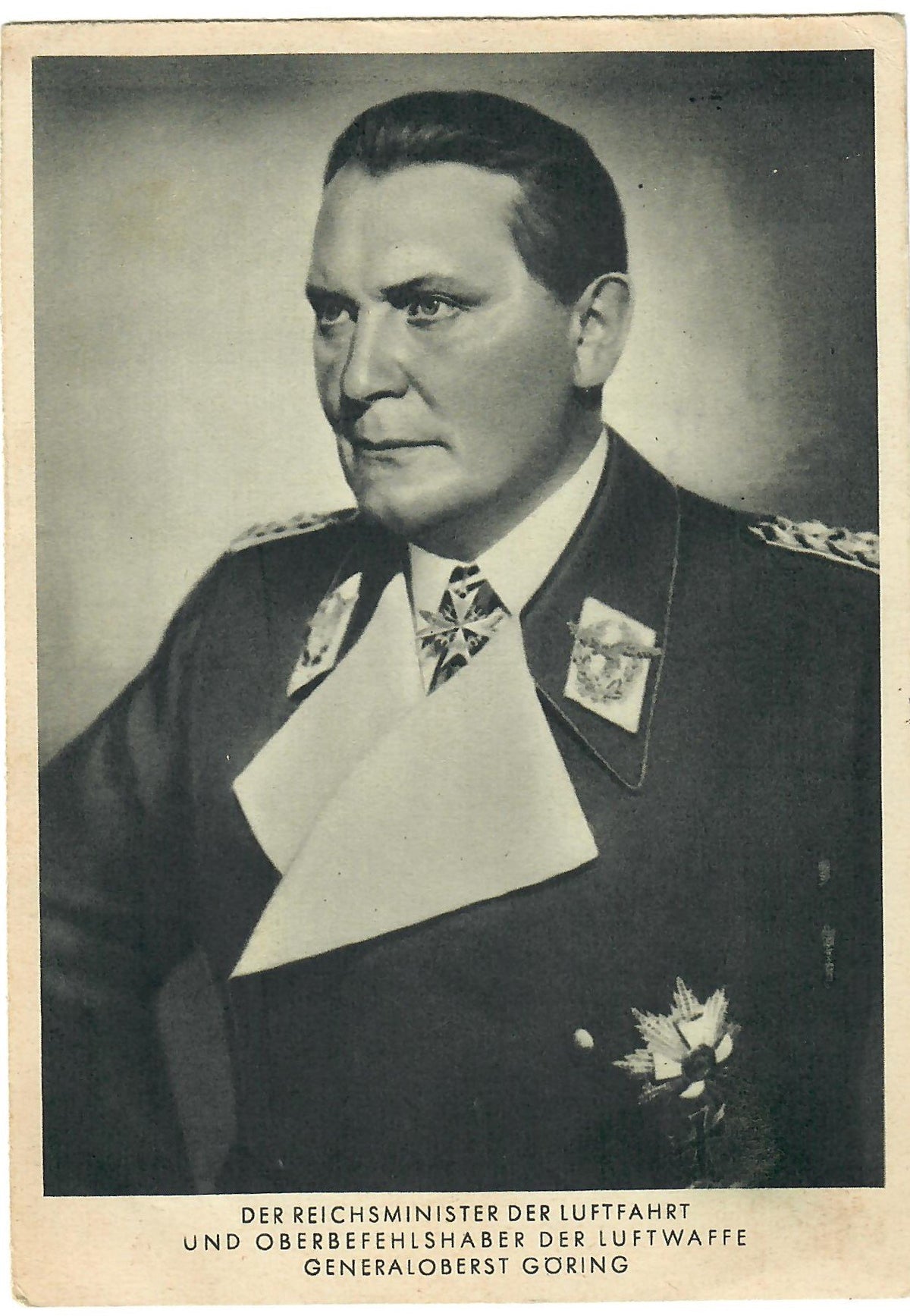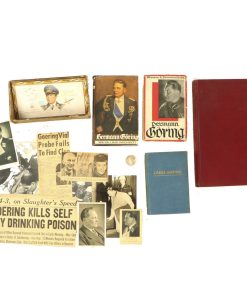Original German 1946 Hermann Goering Nuremberg Trial Collection – Photos, Documents, Newspaper Articles and More Original Items
$ 2.995,00 $ 748,75
Original Items: One-of-a-kind Set. this is a collection of original; photograph, post cards, telegram, news paper articles and other material all related to the 1946 Nuremberg War Crime Trial of Hermann Goering.
In 1946 Göring was flown to Camp Ashcan, a temporary prisoner-of-war camp housed in the Palace Hotel at Mondorf-les-Bains, Luxembourg. Here he was weaned off dihydrocodeine (a mild morphine derivative)—he had been taking the equivalent of three or four grains (260 to 320 mg) of morphine a day—and was put on a strict diet; he lost 60 pounds (27 kg). His IQ was tested while in custody and found to be 138. Top NSDAP officials were transferred in September to Nuremberg, which was to be the location of a series of military tribunals beginning in November.
Göring was the second-highest-ranking official tried at Nuremberg, behind Reich President (former Admiral) Karl Dönitz. The prosecution leveled an indictment of four charges, including a charge of conspiracy; waging a war of aggression; war crimes, including the plundering and removal to Germany of works of art and other property; and crimes against humanity, including the disappearance of political and other opponents under the Nacht und Nebel (Night and Fog) decree; the torture and ill-treatment of prisoners of war; and the murder and enslavement of civilians, including what was at the time estimated to be 5,700,000 Jews. Not permitted to present a lengthy statement, Göring declared himself to be “in the sense of the indictment not guilty”.
The trial lasted 218 days; the prosecution presented their case from November through March, and Göring’s defense—the first to be presented—lasted from 8 to 22 March. The sentences were read out on 30 September 1946.[129] Göring, forced to remain silent while seated in the dock, communicated his opinions about the proceedings using gestures, shaking his head, or laughing. He constantly took notes and whispered with the other defendants, and tried to control the erratic behavior of Hess, who was seated beside him.[130] During breaks in the proceedings, Göring tried to dominate the other defendants, and he was eventually placed in solitary confinement when he attempted to influence their testimony. Göring told US psychiatrist Leon Goldensohn that the court was “stupid” to try “little fellows” like Funk and Kaltenbrunner instead of letting Göring take all the blame on himself.He also claimed that he had never heard of most of the other defendants before the trial.
On several occasions over the course of the trial, the prosecution showed films of the Camps and other atrocities. Everyone present, including Göring, found the contents of the films shocking; he said that the films must have been faked. Witnesses, including Paul Koerner and Erhard Milch, tried to portray Göring as a peaceful moderate. Milch stated it had been impossible to oppose Adolph or disobey his orders; to do so would likely have meant death for oneself and one’s family. When testifying on his own behalf, Göring emphasized his loyalty to Adolph, and claimed to know nothing about what had happened in the Camps, which were under Himmler’s control. He gave evasive, convoluted answers to direct questions and had plausible excuses for all his actions during the war. He used the witness stand as a venue to expound at great length on his own role in the Reich, attempting to present himself as a peacemaker and diplomat before the outbreak of the war.[134] During cross-examination, chief prosecutor Robert H. Jackson read out the minutes of a meeting that had been held shortly after Kristallnacht, a major pogrom in November 1938. At the meeting, Göring had plotted to confiscate Jewish property in the wake of the pogrom. Later, David Maxwell-Fyfe proved it was impossible for Göring not to have known about the Stalag Luft III murders—the shooting of fifty airmen who had been recaptured after escaping from Stalag Luft III—in time to have prevented the killings. He also presented clear evidence that Göring knew about the extermination of the Hungarian Jews.
Göring was found guilty on all four counts and was sentenced to death by hanging. The judgment stated:
There is nothing to be said in mitigation. For Göring was often, indeed almost always, the moving force, second only to his leader. He was the leading war aggressor, both as political and as military leader; he was the director of the slave labor program and the creator of the oppressive program against the Jews and other races, at home and abroad. All of these crimes he has frankly admitted. On some specific cases there may be conflict of testimony, but in terms of the broad outline, his own admissions are more than sufficiently wide to be conclusive of his guilt. His guilt is unique in its enormity. The record discloses no excuses for this man.
Göring made an appeal asking to be shot as a soldier instead of hanged as a common criminal, but the court refused. He committed suicide with a potassium cyanide capsule the night before he was to be hanged.
One theory as to how Göring obtained the poison holds that US Army Lieutenant Jack G. Wheelis, who was stationed at the Nuremberg Trials, retrieved the capsules from their hiding place among Göring’s personal effects that had been confiscated by the Army and handed them over to the prisoner, after being bribed by Göring, who gave him his gold watch, pen, and cigarette case. In 2005, former US Army Private Herbert Lee Stivers, who served in the 1st Infantry Division’s 26th Infantry Regiment—the honour guard for the Nuremberg Trials—claimed he gave Göring “medicine” hidden inside a fountain pen that a German woman had asked him to smuggle into the prison. Stivers later said that he did not know what was in the pill until after Göring’s suicide.
Göring’s body, as with those of the men who were executed, was displayed at the execution ground for the witnesses of the executions. The bodies were cremated at Ostfriedhof, Munich, and the ashes were scattered in the Isar River.
Fast Shipping with Professional Packaging
Thanks to our longstanding association with UPS FedEx DHL, and other major international carriers, we are able to provide a range of shipping options. Our warehouse staff is expertly trained and will wrap your products according to our exact and precise specifications. Prior to shipping, your goods will be thoroughly examined and securely secured. We ship to thousands clients each day across multiple countries. This shows how we're dedicated to be the largest retailer on the internet. Warehouses and distribution centres can be located throughout Europe as well as the USA.
Note: Orders with more than one item will be assigned a processing date depending on the item.
Before shipping before shipping, we'll conduct a thorough inspection of the items you have ordered. Today, the majority of orders will be delivered within 48 hours. The delivery time will be between 3-7 days.
Returns
The stock is dynamic and we cannot completely manage it because multiple stakeholders are involved, including our factory and warehouse. So the actual stock may alter at any time. It's possible that you may not receive your order once the order has been made.
Our policy is valid for a period of 30 days. If you don't receive the product within 30 days, we are not able to issue a refund or an exchange.
You can only return an item if it is unused and in the same state as the day you received it. You must have the item in its original packaging.
Related products
Uncategorized
Uncategorized
Angolan Rebel 1970s era 60mm Inert Display Mortar from Angolan Civil War Original Items
Uncategorized
Uncategorized
Uncategorized
Uncategorized
Uncategorized
Uncategorized
Uncategorized
Uncategorized
Uncategorized
Band of Brothers ORIGINAL GERMAN WWII Le. F.H. 18 10.5cm ARTILLERY PIECE Original Items
Uncategorized
Uncategorized
Uncategorized
Uncategorized
Uncategorized
Uncategorized
Armored Burgonet Helmet & Polearm from Scottish Castle Leith Hall Circa 1700 Original Items













































































